Grease Trail Digital Storytelling Project Overview
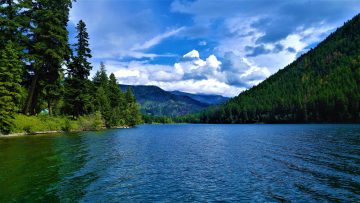
Photo Courtesy of Flickr by Jennifer C.
The ancestors are continuously present today on the landscapes. They have left us ancient names, hand tools, and trails. We bring them to life in singing their songs and telling their stories. We continue to use their language and we are acquainted with their cherished places. The past and the present merge together into the future.
Linda Smith Myers, Tŝilhqot’in Nation (pg. 15, 2008).
The Grease Trail Digital Storytelling project was situated on unceded territories of Tŝilhqot’in, Dakelh, and Secwépemc First Nations. The Grease Trail Digital Storytelling project was a land-based experiential learning opportunity for Indigenous pre-service teachers in rural communities of north-central BC, Canada, to engage in traditional Indigenous storytelling practices in digital teaching and learning contexts. The main aims of the Grease Trail Storytelling project are situated within the 4Rs of Indigenous knowledge:
- Respect: Understand local Indigenous knowledges to expand Indigenous-focused digital curricular
- Relevance: Develop digital storytelling as an instructional tool to enhance learning
- Responsibility: Provide land-based learning opportunities to build capacity for diversity and inclusion in teaching and learning contexts
- Reciprocity: Create open Indigenous digital storytelling educational resources for schools and Indigenous communities
Across generations, the Nuxalk-Carrier Grease Trail has been an essential exchange corridor. Its namesake is from when oolichan grease stained the route. Today, Indigenous people and Settlers still use the trail to connect with each other and the land (see Grease Trail Map here). An important aspect of the Nuxalk-Carrier Grease Trail are stories of ancestors, animals, families, landscapes, and culture. Since time immemorial, Indigenous oral traditions and stories have been an intergenerational way to promote learning transformation.
The Grease Trail Digital Storytelling project was guided by the Tŝilhqot’in National Government who emphasized a priority for the creation of local Indigenous language resources to promote language revitalization among younger generations. Further, the Tŝilhqot’in Nation Government Education Department assisted with inviting Elders and Storytellers to meet with Indigenous Teacher Candidates during Talking Circles.
Through the Grease Trail Digital Storytelling project, we consider the importance of Indigenous storytelling and explore land-based teaching strategies for creating digital storytelling resources. The first year of the Grease Trail Digital Storytelling project was completed between October 2019 to April 2020. Take a moment to listen to seven podcasts, ranging from 6 to 18 minutes in duration and produced in the north-central BC. We are continuing our journey into the second year with Indigenous Teacher Candidates enrolled in the Cariboo Field Centre.
Our Stories
Season 1, Episode 1: Ice Fishing and Netting Photo Courtesy of Flickr by Emilia Eriksson
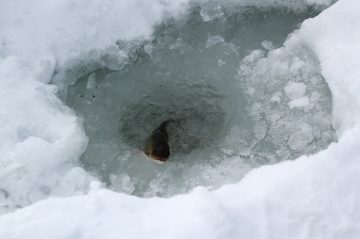 Chanel Wynja, Secwépemc and Tŝilhqot’in Nations, and Stella Stump, Tŝilhqot’in Nation, were in their third year of their Bachelor of Education through NITEP, an Indigenous Teacher Education Program located at the Cariboo Field Centre. The digital storytelling project titled Ice Fishing and Netting displays Tŝilhqot’in knowledge and values shared by Elder Lucy Squalian. The episode is an interview spoken in Nenqayni ch’ih language. This podcast is approximately 14 minutes in duration, recorded in Williams Lake BC, and produced in April 2020. The intended audience is educators, schools, and community. The podcast is classified as an informative category. The main themes of the episode are Tŝilhqot’in knowledge, oral traditions and revitalizing Nenqayni ch’ih language.
Chanel Wynja, Secwépemc and Tŝilhqot’in Nations, and Stella Stump, Tŝilhqot’in Nation, were in their third year of their Bachelor of Education through NITEP, an Indigenous Teacher Education Program located at the Cariboo Field Centre. The digital storytelling project titled Ice Fishing and Netting displays Tŝilhqot’in knowledge and values shared by Elder Lucy Squalian. The episode is an interview spoken in Nenqayni ch’ih language. This podcast is approximately 14 minutes in duration, recorded in Williams Lake BC, and produced in April 2020. The intended audience is educators, schools, and community. The podcast is classified as an informative category. The main themes of the episode are Tŝilhqot’in knowledge, oral traditions and revitalizing Nenqayni ch’ih language.
Season 1, Episode 2: Lhin Desch'osh (Stone Dog) Legend Photo Courtesy of Tŝilhqot’in Nation
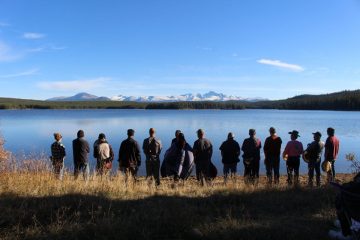 Lorianne Alphonse is a proud member from the Yunesit'in Government of Tŝilhqot’in Nation. She was in her third year of her Bachelor of Education through NITEP, an Indigenous Teacher Education Program located at the Cariboo Field Centre. Lorianne worked as a Nenqayni ch’ih Language Teacher for School District #27. In this digital storytelling project, Lhin Desch’osh (Stone Dog) Legend is a story narrated by Lorianne in both English and Nenqayni ch’ih languages. This episode raises awareness of Tŝilhqot’in oral histories as an act of resurgence in traditional storytelling, as well as a reclamation of sovereignty to acknowledge Aboriginal title and land rights. The episode is approximately 18 minutes in duration, recorded in Williams Lake, BC, and produced in April 2020. The intended audience are educators as well as secondary students. The podcast is classified as an informative category. The main themes of the episode are Indigenous land rights, oral traditions and Nenqayni ch’ih language.
Lorianne Alphonse is a proud member from the Yunesit'in Government of Tŝilhqot’in Nation. She was in her third year of her Bachelor of Education through NITEP, an Indigenous Teacher Education Program located at the Cariboo Field Centre. Lorianne worked as a Nenqayni ch’ih Language Teacher for School District #27. In this digital storytelling project, Lhin Desch’osh (Stone Dog) Legend is a story narrated by Lorianne in both English and Nenqayni ch’ih languages. This episode raises awareness of Tŝilhqot’in oral histories as an act of resurgence in traditional storytelling, as well as a reclamation of sovereignty to acknowledge Aboriginal title and land rights. The episode is approximately 18 minutes in duration, recorded in Williams Lake, BC, and produced in April 2020. The intended audience are educators as well as secondary students. The podcast is classified as an informative category. The main themes of the episode are Indigenous land rights, oral traditions and Nenqayni ch’ih language.
Season 1, Episode 3: Canada's Genocide - Highway of Tears Image Courtesy of The Museum of Anthropology, UBC - Ha̱yulis tła̱n’s ma̱lkwa̱lał (We Will Always Remember) by Coral Shaughnessy-Moon. 2020 Winner of the MOA Shop Emerging Indigenous Artist.
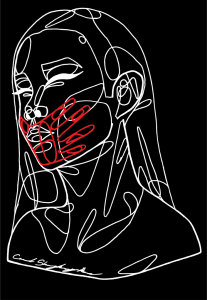 Alyssa Mortensen and Ashley Bueckert are both in their third year of NITEP, an Indigenous Teacher Education Program at the University of British Columbia. Alyssa and Ashley are both from the Wet’suwet’en Nation, specifically Hagwilget Village which is located in Hazelton, B.C. They both work at elementary schools as Indigenous Education Support Workers. Their digital storytelling project titled Canada’s Genocide: Highway of Tears challenges dominant history told about Indigenous women and girls who have been targets of violence along Highway 16 in Northern BC. The Highway of Tears was something that hit close to home for both Alyssa and Ashley, as their home community falls along the Highway of Tears. Tragically, for over five decades, a northern BC highway corridor has had a disproportionate number of murders and disappearances of Indigenous women and girls (see the Highway of Tears Map here; National Inquiry into MMWIG 2019). This episode brings to light the importance of discussing Missing and Murdered Indigenous Women in Canada. The podcast is classified as an informative category. The main themes of the episode are Indigenous feminism and social justice activism.
Alyssa Mortensen and Ashley Bueckert are both in their third year of NITEP, an Indigenous Teacher Education Program at the University of British Columbia. Alyssa and Ashley are both from the Wet’suwet’en Nation, specifically Hagwilget Village which is located in Hazelton, B.C. They both work at elementary schools as Indigenous Education Support Workers. Their digital storytelling project titled Canada’s Genocide: Highway of Tears challenges dominant history told about Indigenous women and girls who have been targets of violence along Highway 16 in Northern BC. The Highway of Tears was something that hit close to home for both Alyssa and Ashley, as their home community falls along the Highway of Tears. Tragically, for over five decades, a northern BC highway corridor has had a disproportionate number of murders and disappearances of Indigenous women and girls (see the Highway of Tears Map here; National Inquiry into MMWIG 2019). This episode brings to light the importance of discussing Missing and Murdered Indigenous Women in Canada. The podcast is classified as an informative category. The main themes of the episode are Indigenous feminism and social justice activism.
Season 1, Episode 4: Multi-Layered Indigenous Storytelling - Maintaining Life's Wellness and Balance Photo Courtesy of Flickr by pentaboxes
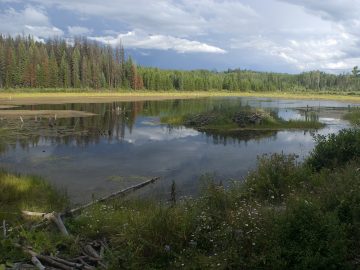 Corly Schmeisser, Secwépemc Nation, and Suzanne Gurney, Metis Nation, were both in their third year of their Bachelor of Education through NITEP, an Indigenous Teacher Education Program located at the Cariboo Field Centre. The digital storytelling project titled Multi-Layered Indigenous Storytelling - Maintaining Life's Wellness and Balance displays storytelling which has been used to share knowledge, wisdom, and humour traditionally within Indigenous communities. With the use of technology, one can share old stories in new ways. The episode is approximately 11 minutes in duration, recorded in Quesnel BC, and produced in April 2020. The intended audience is educators, schools, and communities. The podcast is classified as an informative category. The main themes of the episode are Indigenous knowledge, oral storytelling, and health and wellness.
Corly Schmeisser, Secwépemc Nation, and Suzanne Gurney, Metis Nation, were both in their third year of their Bachelor of Education through NITEP, an Indigenous Teacher Education Program located at the Cariboo Field Centre. The digital storytelling project titled Multi-Layered Indigenous Storytelling - Maintaining Life's Wellness and Balance displays storytelling which has been used to share knowledge, wisdom, and humour traditionally within Indigenous communities. With the use of technology, one can share old stories in new ways. The episode is approximately 11 minutes in duration, recorded in Quesnel BC, and produced in April 2020. The intended audience is educators, schools, and communities. The podcast is classified as an informative category. The main themes of the episode are Indigenous knowledge, oral storytelling, and health and wellness.
Season 1, Episode 5: The Shuswap Sweathouse Photo Courtesy of Flickr by Bill Eager
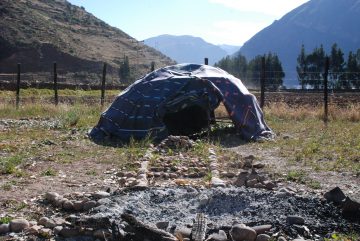 Valarie Johnson proudly belongs to the Secwépemc Nation of Esk’et within the Cariboo interior of B.C. She was in her third year of an Indigenous Teacher Education Program (NITEP) through the University of British Columbia. Valarie’s digital storytelling project titled The Sweat Lodge promotes the theme of wellness throughout Indigenous youth and education which creates big ideas, cultural context, and displays relationships between the land and social interactions which influence values that will shape the mental, physical, spiritual, and well-being of our future generations. One of the main discussions throughout the podcast is about a community sweat house which allows the audience to engage and reflect on their strengths and work towards a holistic balance. The episode is approximately 16 minutes in duration, recorded in Williams Lake BC, and produced in April 2020. The podcast is classified as an informative category. The main themes of the episode are holistic wellness and language revitalization.
Valarie Johnson proudly belongs to the Secwépemc Nation of Esk’et within the Cariboo interior of B.C. She was in her third year of an Indigenous Teacher Education Program (NITEP) through the University of British Columbia. Valarie’s digital storytelling project titled The Sweat Lodge promotes the theme of wellness throughout Indigenous youth and education which creates big ideas, cultural context, and displays relationships between the land and social interactions which influence values that will shape the mental, physical, spiritual, and well-being of our future generations. One of the main discussions throughout the podcast is about a community sweat house which allows the audience to engage and reflect on their strengths and work towards a holistic balance. The episode is approximately 16 minutes in duration, recorded in Williams Lake BC, and produced in April 2020. The podcast is classified as an informative category. The main themes of the episode are holistic wellness and language revitalization.
Season 1, Episode 6: Self-care Strategies and Wellness Photo Courtesy of Flickr by Karen Neoh
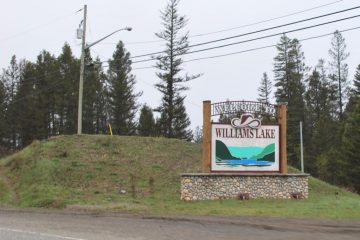 Alice Hird, Ulkatcho Nation, Billi Jean Graham, Ulkatcho Nation, and Corly Schmeisser, Secwépemc Nation, were all in their third year of their Bachelor of Education through NITEP, an Indigenous Teacher Education Program located at the Cariboo Field Centre. The digital storytelling project titled Self-care Strategies and Wellness discusses tools to cope with stressful environments and tips for self-care. The episode is approximately 6 minutes in duration, recorded in Williams Lake BC, and produced in April 2020. The intended audience is educators, schools, and communities. The podcast is classified as an informative category.
Alice Hird, Ulkatcho Nation, Billi Jean Graham, Ulkatcho Nation, and Corly Schmeisser, Secwépemc Nation, were all in their third year of their Bachelor of Education through NITEP, an Indigenous Teacher Education Program located at the Cariboo Field Centre. The digital storytelling project titled Self-care Strategies and Wellness discusses tools to cope with stressful environments and tips for self-care. The episode is approximately 6 minutes in duration, recorded in Williams Lake BC, and produced in April 2020. The intended audience is educators, schools, and communities. The podcast is classified as an informative category.
Season 1, Episode 7: Learning My Language, Learning Our Ways Photo Courtesy of Flickr by Sam Beebe
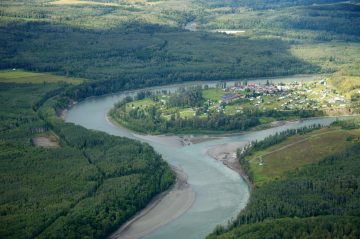 Jessica Creyke is a proud member from the Wet’suwet’en Nation. Jessica was in her third year of an Indigenous Teacher Education Program (NITEP) through the University of British Columbia. The digital storytelling project titled Learning My Language, Learning Our Ways displays storytelling which has been used to share knowledge, learn language, as well as traditions. The episode is approximately 12 minutes in duration, recorded in Prince George BC, and produced in April 2020. The intended audience is educators, schools, and communities. The podcast is classified as an informative category. The main themes of the episode are Indigenous knowledge, oral storytelling, and language learning.
Jessica Creyke is a proud member from the Wet’suwet’en Nation. Jessica was in her third year of an Indigenous Teacher Education Program (NITEP) through the University of British Columbia. The digital storytelling project titled Learning My Language, Learning Our Ways displays storytelling which has been used to share knowledge, learn language, as well as traditions. The episode is approximately 12 minutes in duration, recorded in Prince George BC, and produced in April 2020. The intended audience is educators, schools, and communities. The podcast is classified as an informative category. The main themes of the episode are Indigenous knowledge, oral storytelling, and language learning.
Acknowledgement:
This two-year project is funded in part by the University of British Columbia’s Teaching and Learning Enhancement Fund.